| |
13:30
|
0388.
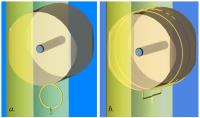 |
Numerical evaluation of the optimal coupling scheme of a
cylindrical dielectric resonator operating at 600 MHz (14T) 
Wei Luo1, Rui Liu2, Thomas Neuberger3,4,
and Michael T Lanagan1,2
1Material Research Institute, University Park,
PA, United States, 2Department
of Engineering Science and Mechanics, University Park, PA,
United States, 3Huck
Institute of Life Science, University Park, PA, United
States, 4Department
of Biomedical Engineering, University Park, PA, United
States
To maximize the energy transfer to the cylindrical
dielectric resonator utilized in magnetic resonant imaging
probe head, a three-loop coupling method was investigated
using electromagnetic field simulations. The simulation
results demonstrate the supreme performance of this coupling
method and verify the previous preliminary experimental
results.
|
| |
13:42
|
0389.
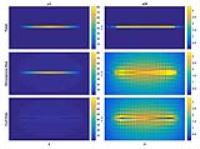 |
More than meets the eye: The mixed character of electric dipole
coils, and implications for high-field performance 
Daniel K Sodickson1,2, Graham C Wiggins1,2,
Gang Chen1,2, Karthik Lakshmanan1, and
Riccardo Lattanzi1,2
1Center for Advanced Imaging Innovation and
Research (CAI2R) and Bernard and Irene Schwartz Center for
Biomedical Imaging, Department of Radiology, New York
University School of Medicine, New York, NY, United States, 2Sackler
Institute of Graduate Biomedical Sciences, New York
University School of Medicine, New York, NY, United States
We present a fundamental electrodynamic explanation for the
SNR performance of electric dipole antennae at high field.
We demonstrate that typical electric dipole coils combine
divergence-free and curl-free surface current components,
allowing them to exceed the performance limits for either
component alone. We also show that z-directed electric
dipoles have a strong overlap with ideal current patterns
associated with the ultimate intrinsic SNR at high field
strength.
|
| |
13:54
 |
0390.
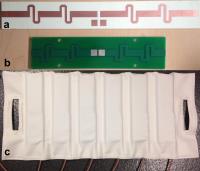 |
Towards imaging the body at 10.5 Tesla using a fractionated
dipole antenna array 
M. Arcan Erturk1, Gregor Adriany1,
Pierre-Francois Van de Moortele1, Yigitcan
Eryaman1, Alexander J Raaijmakers2,
Lance DelaBarre1, Edward Auerbach1, J.
Thomas Vaughan1, Kamil Ugurbil1, and
Gregory J Metzger1
1Center for Magnetic Resonance Research,
University of Minnesota, Minneapolis, MN, United States, 2Imaging
Division, UMC Utrecht, Utrecht, Netherlands
We have developed a fractionated dipole antenna (fDA) for
body imaging at 10.5T, investigated its electro-magnetic
field behavior in a 10-channel array using numerical
simulations in a human model, and compared its performance
to a 10-channel fDA array at 7.0T. The 10.5T fDA array
provided similar B1+ transmit efficiency and peak
10g-averaged SAR compared to the 7.0T array inside the
prostate, however had a less uniform B1+ distribution.
Simulation results indicated that fDA elements have
sufficient B1+ penetration at 10.5T, but B1+
non-uniformities may need to be alleviated even in small
imaging targets using dynamic RF strategies including
parallel transmit.
|
| |
14:06
 |
0391.
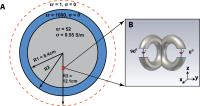 |
Disentangling Signal propagation and Noise-related Effects in
the Presence of High Permittivity Materials via Ideal Current
Patterns 
Manushka V. Vaidya1,2,3, Christopher M. Collins1,2,3,
Daniel K. Sodickson1,2,3, Giuseppe Carluccio1,2,
and Riccardo Lattanzi1,2,3
1Center for Advanced Imaging Innovation and
Research (CAI2R), Department of Radiology, New York
University School of Medicine, New York, NY, United States, 2Bernard
and Irene Schwartz Center for Biomedical Imaging, Department
of Radiology, New York University School of Medicine, New
York, NY, United States, 3Sackler
Institute of Graduate Biomedical Sciences, New York
University School of Medicine, New York, NY, United States
There is no single mechanism to describe how high
permittivity materials (HPMs) improve signal-to-noise ratio
when placed between radiofrequency coils and the object. We
separately investigated the effects of HPMs on signal
propagation and sample noise by studying ideal current
patterns, the corresponding optimal electric (E)
field and a signal-only propagation model. Our results
suggest that phase changes in the ideal current patterns
with HPMs are primarily due to signal-propagation effects
while their increase in size is due to reduced E field
penetration into the sample, which allows larger current
patterns that maximize signal reception with a limited noise
penalty.
|
| |
14:18
|
0392.
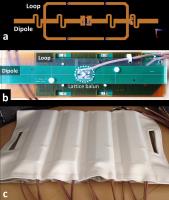 |
Combined loop-dipole transceiver array for body imaging at 7.0
Tesla 
M. Arcan Erturk1, Alexander J Raaijmakers2,
Gregor Adriany1, Kamil Ugurbil1, and
Gregory J Metzger1
1Center for Magnetic Resonance Research,
University of Minnesota, Minneapolis, MN, United States, 2Imaging
Division, UMC Utrecht, Utrecht, Netherlands
We developed a 16-channel transceiver body array (16LD) by
combining loop and dipole elements, and compared performance
against 16-channel microstrip-line (16ML) and 10-channel
fractionated dipole antenna (10DA) arrays. Complementary
field characteristics of loop and dipole elements were
utilized by symmetrically placing them along their
long-axes. The loop-dipole combination allowed increased
channel counts and density while limiting inter-element
coupling. The 16LD had improved transmit and receive
performance over the 16ML and 10DA in both simulations and
experiments. Images of the prostate, kidneys and heart were
acquired showing the potential of the 16LD to successfully
image targets throughout the body at 7.0T.
|
| |
14:30
|
0393.
 |
Modular 7 Tesla transmit/receive arrays designed using thin very
high permittivity dielectric resonator antennas 
Thomas O'Reilly1, Thomas Ruytenberg1,
Bart Steensma2, Alexander Raaijmakers2,
and Andrew Webb1
1Leiden University Medical Centre, Leiden,
Netherlands, 2Utrecht
Medical Centre, Utrecth, Netherlands
A transmit/receive dielectric resonator antenna array has
been designed for operation at 7 Tesla. By using very thin
high permittivity material the inter-element coupling is
very low, allowing small resonators to be placed very close
to one another. An eight-element array has been simulated
and constructed, and in vivo images of the extremities
acquired.
|
| |
14:42
|
0394.
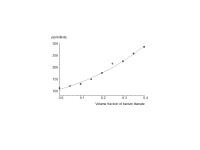 |
Practical improvements in the design of high permittivity pads
for dielectric shimming in 7T neuroimaging 
Thomas O'Reilly1, Wyger Brink1, and
Andrew Webb1
1Leiden University Medical Centre, Leiden,
Netherlands
Improvements are proposed for practical use of high
permittivity materials in high field neuroimaging. These
result in a simple formula to design materials with
specified permittivity, formulation to improve the short
term rigidity and long term stability of the material, and a
method to incorporate devices such as headphones into the
dielectric pad design.
|
| |
14:54
|
0395.
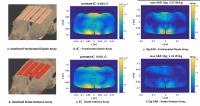 |
Body imaging at 7 Tesla with much lower SAR levels: an
introduction of the Snake Antenna array 
Bart Steensma1, Alexa Viviana Obando Andrade2,
Dennis Klomp1, Nico van den Berg1,
Peter Luijten1, and Alexander Raaijmakers1
1University Medical Centre Utrecht, Utrecht,
Netherlands, 2TU
Delft, Utrecht, Netherlands
The snake antenna is introduced as a novel transmit array
element for body-imaging at ultrahigh-field strengths. It
has been shown in simulations that the snake antenna causes
a very low local peak SAR compared to the fractionated
dipole antenna, while maintaining sufficient B1+-signal
strength. In vivo prostate scans show that the snake antenna
array reaches a B1+-signal strength in the prostate that is
slightly higher than the signal strength reached by the
fractionated dipole antenna array. The lower SAR of the
snake antenna considerably relaxes scanning constraints for
body imaging.
|
| |
15:06
|
0396.
 |
Prospect of SNR and SAR Improvement on a Whole-body Human 10.5T
Scanner using High Dielectric Material 
Sebastian Rupprecht1, Hannes M Wiesner2,
Pierre-Francois van De-Mortelle2, Byeong-Yeul Lee2,
Wei Luo3, Xiao-Hong Zhu2, Isaiah Duck1,
Gregor Adriany2, Christopher Sica1,
Kamil Ugurbil2, Michael Lanagan3, Wei
Chen2, and Qing Yang1
1Department of Radiology, The Pennsylvania State
University College of Medicine, Hershey, PA, United States, 2Radiology
Department, Center for Magnetic Resonance Research,
Minneapolis, MN, United States,3Department of
Engineering Sciences and Mechanics, The Pennsylvania State
University, State College, PA, United States
We compared and characterized the RF field wave behavior for
human brain imaging at
10.5T and 7T. Additionally we explored
the feasibility of using monolithic high dielectric constant
materials to potentially further enhance SNR and circumvent
SAR limitations and show that there can be great benefits
through phantom experiments and computer modeling.
|
| |
15:18
|
0397.
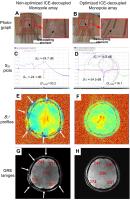 |
Optimized ICE-decoupled Monopole Array for Human Head Imaging at
7T 
Xinqiang Yan1 and
Xiaoliang Zhang2
1Key Laboratory of Nuclear Analysis Techniques,
Institute of High Energy Physics, Chinese Academy of
Sciences, Beijing, China, People's Republic of, 2Department
of Radiology and Biomedical Imaging, University of
California San Francisco, San Francisco, CA, United States
Induced current elimination (ICE) method has proved to be a
useful approach in decoupling radiative monopole and dipole
arrays. In this study, we aim to investigate the effect of
ICE decoupling elements and their position to the B1 fields. The
MR imaging and simulation results show that an optimized
arrangement of ICE decoupling elements can be found to
minimize the perturbation of decoupling elements. Compared
with the non-optimized ICE decoupled monopole array, the
optimized array has more homogeneous transmit field and has
no dark spots or signal cancellations in the MR images.
|
|










